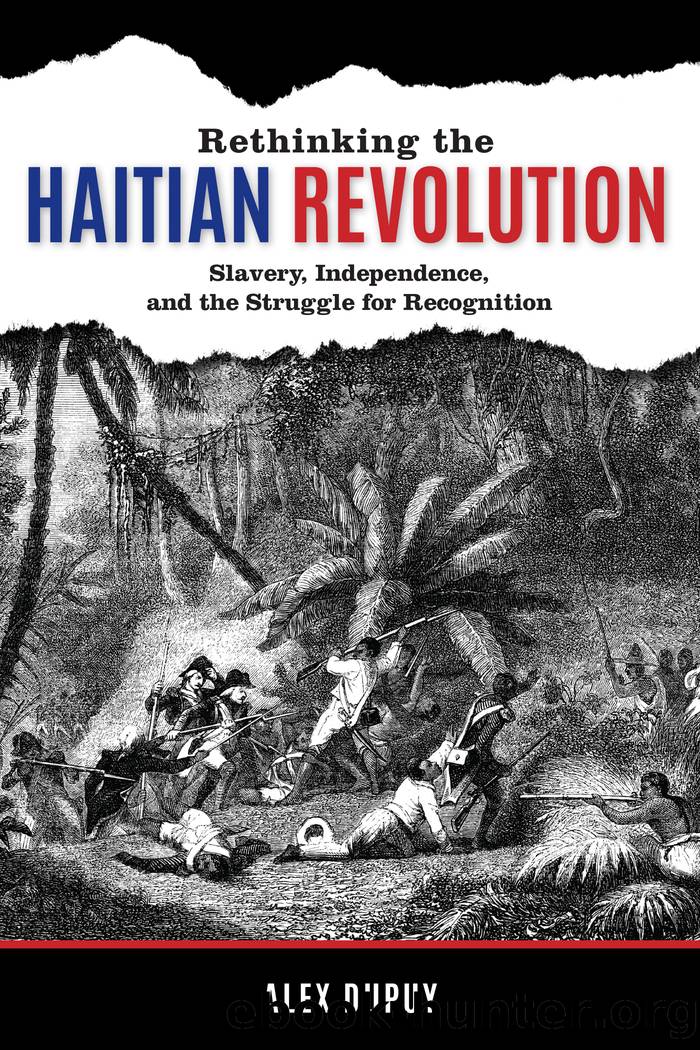Rethinking the Haitian Revolution by Alex Dupuy;

Author:Alex Dupuy;
Language: eng
Format: epub
Tags: undefined
Publisher: Rowman & Littlefield Publishing Group, Inc.
Published: 2012-03-15T00:00:00+00:00
The system of racial stratification, therefore, straddled and contradicted the class system in Saint-Domingue, in such a way that in the vertical divisions of class emerged an impermeable horizontal racial division among whites, mulattoes, and blacks. The ideologies of race and racism, therefore, became parts of the system of social class and class closure to enable whites to monopolize the positions of power and privilege in the colony.[2] But while the racial order unified whites against mulattoes and blacks, it did not change the class divisions between whites. In fact, by creating a sense of solidarity among whites, the racial system reinforced the dominance of the grands blancs over the petits blancs and prevented the latter from challenging the former by forming an alliance with the mulattoes, with whom they shared much in common. At the same time, mulattoes who opposed the racism of the whites and fought to achieve equality with them also despised the blacks and defended the slave system. They, therefore, could not turn to the blacks to unite with them to oppose slavery and the racial system until they realized that freeing the slaves was in fact the only way they could win their own freedom from racial exclusion and oppression. As Aimé Césaire put it so poignantly, âthe black stain of the mulatto, indelible as it must be, must mark his place. Foreverâ (Césaire 1960, 14).
Thus, even though the ârace questionâ cannot be reduced to the âclass question,â it cannot be understood independently of the system of class relations in a specific society at specific points in time. Individuals with the same skin color may be classified differently depending on their structural location or class position in different societies. This explains why the construction of a system of racial/color hierarchy and the elaboration of ideologies of racial/color differences to justify the unequal positions of members of such racial/color groups differ from society to society, or even within the same society to reflect the shifts in the structural location of and power relations among different groups. Put differently, class divisions cut through racially designated social groups, and race/color relations never exist independently of class relations. Practices of racial distinctions and racism, therefore, always articulate with other class practices and their economic, political, and ideological manifestations in a specific society in the context of that societyâs position in the hierarchical international division of labor of the capitalist world economy (Dupuy 2014, 7â32). In other words, visible physical differences by themselves do not explain racism. Barbara Fields expressed this point succinctly when she wrote that ârace is not an element of human biology . . . nor is it an idea that can be plausibly imagined to live an eternal life of its own. Race is not an idea but an ideology. It came into existence at a distinctive historical moment for rationally understandable historical reasons and is subject to change for similar reasonsâ (Fields 1990, 101; also cited in Dupuy 2014, 11).
In the case of Saint-Domingue, then,
Download
This site does not store any files on its server. We only index and link to content provided by other sites. Please contact the content providers to delete copyright contents if any and email us, we'll remove relevant links or contents immediately.
| Antigua | Bahamas |
| Barbados | Cuba |
| Dominica | Dominican Republic |
| Grenada | Haiti |
| Jamaica | Saint Kitts |
| Saint Lucia | Saint Vincent |
| Trinidad and Tobago |
Cat's cradle by Kurt Vonnegut(15258)
Pimp by Iceberg Slim(14434)
4 3 2 1: A Novel by Paul Auster(12330)
Underground: A Human History of the Worlds Beneath Our Feet by Will Hunt(12052)
The Radium Girls by Kate Moore(11973)
Wiseguy by Nicholas Pileggi(5708)
The Fire Next Time by James Baldwin(5382)
Perfect Rhythm by Jae(5355)
American History Stories, Volume III (Yesterday's Classics) by Pratt Mara L(5274)
Paper Towns by Green John(5138)
Pale Blue Dot by Carl Sagan(4954)
A Higher Loyalty: Truth, Lies, and Leadership by James Comey(4906)
The Mayflower and the Pilgrims' New World by Nathaniel Philbrick(4459)
The Doomsday Machine by Daniel Ellsberg(4449)
Killers of the Flower Moon: The Osage Murders and the Birth of the FBI by David Grann(4409)
The Sympathizer by Viet Thanh Nguyen(4342)
Too Much and Not the Mood by Durga Chew-Bose(4302)
The Borden Murders by Sarah Miller(4276)
Sticky Fingers by Joe Hagan(4144)
